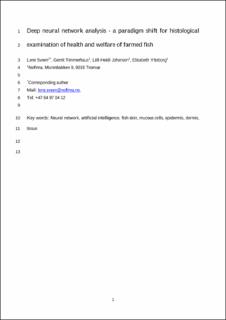| dc.contributor.author | Sveen, Lene | |
| dc.contributor.author | Timmerhaus, Gerrit | |
| dc.contributor.author | Johansen, Lill-Heidi | |
| dc.contributor.author | Ytteborg, Elisabeth | |
| dc.date.accessioned | 2021-08-31T07:56:30Z | |
| dc.date.available | 2021-08-31T07:56:30Z | |
| dc.date.created | 2020-10-16T14:17:51Z | |
| dc.date.issued | 2021 | |
| dc.identifier.citation | Aquaculture. 2021, 532 1-12. | |
| dc.identifier.issn | 0044-8486 | |
| dc.identifier.uri | https://hdl.handle.net/11250/2771852 | |
| dc.description.abstract | An artificial intelligence model (AI-model) was trained for the first time to detect multi-class segmentation of skin from Atlantic salmon, using a convolutional neural network (Aiforia®). The AI-model was developed to produce reliable spatial measurements of all the successive skin layers of Atlantic salmon. The AI-model was tested on skin samples collected from eight post-smolts (produced in a research facility), with the intention of comparing skin samples from six different body sites. The results from the AI-model were highly correlated to manual measurements carried out by two experienced histologists and indicated that the abundance of epidermal and dermal skin tissues vary with body-site. The AI-model was further used to evaluate skin samples from commercially farmed Atlantic salmon. The samples were taken regularly through a production cycle (autumn 2018 to autumn 2019) and followed major operational events such as transport and de-lousing. Results from the AI-model reviled dynamic behavior of the skin, reflecting spatial changes of skin tissues related to time in the sea, life stage and operational events. Our work illustrates how unbiased datasets from histological analysis open new possibilities for comparative studies of Atlantic salmon physiology. With time, a better understanding of tissue dynamics in relation to production and diseases may arise from automated tissue analyzes. | |
| dc.language.iso | eng | |
| dc.title | Deep neural network analysis - a paradigm shift for histological examination of health and welfare of farmed fish | |
| dc.type | Peer reviewed | |
| dc.type | Journal article | |
| dc.description.version | submittedVersion | |
| dc.source.pagenumber | 1-12 | |
| dc.source.volume | 532 | |
| dc.source.journal | Aquaculture | |
| dc.identifier.doi | 10.1016/j.aquaculture.2020.736024 | |
| dc.identifier.cristin | 1840195 | |
| dc.relation.project | Nofima AS: 12307 | |
| dc.relation.project | Norges forskningsråd: 281106 | |
| dc.relation.project | Norges forskningsråd: 194050 | |
| cristin.ispublished | true | |
| cristin.fulltext | preprint | |
| cristin.qualitycode | 2 | |
